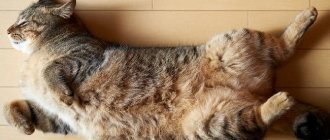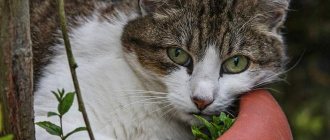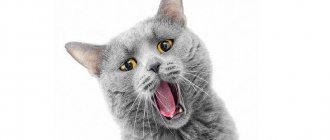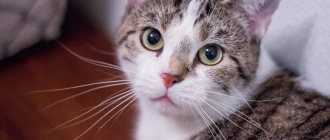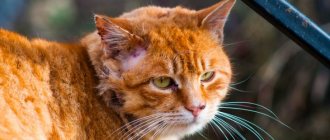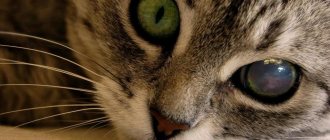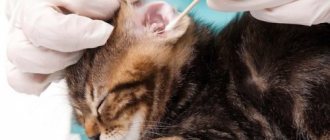A greasy spot on the tail or a completely greasy tail in a cat indicates that the tail gland is producing too much oil. The pathology is not life-threatening: it can rather be called cosmetic. But this does not mean that there is no need to treat your pet: fungi and bacteria may join the process - and then things will be difficult.
The cat has a greasy tail: reasons
Veterinarians do not yet have an exhaustive list of the causes of this condition, because the pathology has not been sufficiently studied. We can only talk about the propensity of certain groups of animals to this problem, as a result of which we can name possible risk factors.
Article continues after advertisement
Tail fat in a cat is most often the result of overworking sebaceous glands caused by increased hormonal levels and imbalances. Veterinarians made this assumption because the problem occurs more often in unsterilized males, so this pathology is also called the tail of the breeder or the tail of breeding cats. It also occurs in females and castrates, but rarely. Although in relation to cats, the connection with hormonal levels is not a proven fact, unlike dogs, in which such a relationship has been studied far and wide.
Sebaceous glands are external secretion glands located in the skin and secrete a fatty secretion - sebum (sebum), consisting of triglycerides, wax esters, fatty acids and squalene. The greatest development is achieved during sexual maturation under the influence of sex hormones.
Tail gland hyperplasia is a seborrheic condition that appears as a collection of seborrheic discharge along the dorsal (upper) portion of the tail.
Another cause of greasy tail may be excessive fat in the diet. If this is the case, the fat content needs to be reduced.
Sebaceous glands on a cat's tail
Pathology often occurs in nurseries where cats are kept in cages. In this case, part of the treatment will be to provide the animal with sufficient space to live.
Also, some doctors cite poor hygiene as one of the reasons: they say the cat doesn’t wash itself well. This opinion seems controversial, because Many cats don't wash themselves very well, but they don't have this problem. And, on the contrary, it happens that cleaners have a greasy tail.
Another version of the causes of the pathology is metabolic disorders, which are often associated with excess weight. In this case, first you need to review your diet and lose weight.
Why does the hair on my back get oily?
This symptom may be a sign of the development of seborrhea, a skin disease that appears due to a violation of the excretory function of the sebaceous glands. This happens due to improper care.
Frequent bathing, washing with shampoos not intended for animals, liver dysfunction are the main factors that provoke excess sebum secretion.
A lack of vitamins and minerals can affect the condition of a cat's hair. It is worth diversifying your pet's diet, including lean meat and rice, and introducing vitamin supplements to improve the quality of the coat.
Development of the problem
When the defect just begins to develop, it may not be noticed, especially in long-haired animals. Then an oily stain appears on the surface of the fur. Then the owners think that the cat has gotten dirty. However, if you pull apart the fur, you can already see that not only the tips of the hairs are in fat, but also their bases, as well as the skin.
Article continues after advertisement
Sebaceous tail syndrome is just beginning and is almost invisible
Further, an increasingly large area of the tail is involved in the process: the pathology acquires a serious scope - it is no longer possible not to notice it. The cat looks dirty and unkempt.
Often, due to hyperplasia of the sebaceous gland, hair falls out on the tail and black crusts form, making it appear as if the cat has a black tail. In addition, you can often notice redness and comedones on the skin (sebaceous plugs, which in small quantities look like individual black dots, and in large quantities - like a black coating on the tail). The color of the coat may also change and concomitant pathologies may develop: secondary bacterial and fungal infection with the formation of boils and pyoderma (purulent skin lesions), as well as seborrheic dermatitis (inflammation of the skin). In general, there are plenty of ugly and unpleasant consequences.
The problem is in development and is already noticeable to the naked eye
As a rule, when owners see fat on a cat's tail, they decide to wash it, but the problem does not go away for long, because... As a result, the gland does not begin to work normally (the cause of the pathology has not been eliminated!) and continues to produce new fat. Washing is an important component of therapy, but by no means the only one. We’ll get to therapy later, but now let’s talk about correct diagnosis.
Dangerous skin diseases of cats
Ringworm
Symptoms: hair loss in certain areas of the skin, peeling, the appearance of strange scales, sometimes purulent wounds. Your cat may itch, but ringworm usually does not cause itching.
Demodicosis
A serious disease caused by microscopic mites. It is highly contagious and develops rapidly. The main symptom is severe, constant scabies, the skin becomes covered with red spots. It starts with the head, ears. Without treatment, it quickly spreads to other areas of the body, appearing consistently in the armpits, on the folds, and at the base of the tail.
Factors predisposing to the appearance of demodicosis are improper feeding, maintenance, lack of a number of B vitamins, vitamin A, E, and worms.
Eczema
The main symptom of eczema is a weeping surface of the skin. The cat scratches the affected area, redness and nodules appear on the skin. The general condition changes: a fever develops, the cat loses weight, and kidney problems begin.
Based on skin scraping tests, your veterinarian will rule out other skin diseases and prescribe antihistamines. It is not recommended to treat the cat yourself, as any incorrect treatment can cause additional complications.
Dermatitis
Dermatitis is dangerous due to its unpredictable manifestations. If left untreated in time, they can severely undermine the animal’s immune system.
Bedsores
Necrotic destruction of a cat's skin due to prolonged lying in one place. Manifested by tissue necrosis, death of skin cells. It is observed in sick animals that are forced to remain in one position for a long time. Symptoms: pain when touched, decreased temperature of the dying area, color change, appearance of ulcers. Prevention of the development of bedsores is simple - turn your pet over more often in the postoperative period, do not let him sit on the injured limb for a long time. Treatment comes down to treating wounds, dressings, and removing dead tissue.
Associated with viral infections
Some feline diseases lead to the development of skin problems. For example, with leukemia
the integument is especially severely affected - abscesses, neoplasms, and wounds occur.
Immunodeficiency in cats
causes chronic otitis media with damage to the skin of the ears, and numerous pustules (vesicles with pus) appear on the body. causes damage to the skin of the paw pads and around the nose.
It is important to promptly seek help from a veterinarian to determine the cause of the skin disease. The specialist will determine the main cause of the soreness and prescribe adequate therapy. The cat scratches itself periodically, but looks quite well
However, once again stroking the pet, the owner notices sores appearing in different places on the cat’s body. What are the reasons why, seemingly asymptomatically, a cat develops sores?
The cat scratches itself periodically, but looks quite well. However, once again stroking the pet, the owner notices the cat’s sores
.
What are the reasons why, seemingly asymptomatically, a cat develops sores
?
Among the broad picture of feline skin diseases, a number of particularly common ailments can be identified, as a result of which the cat develops sores.
Diagnostics
Usually making a diagnosis is not difficult. But differential diagnosis with other dermatological diseases may be required. Sebaceous gland hyperplasia should be distinguished from ringworm, demodex (mite) and neoplasms. These diseases are dangerous, some of them are contagious.
An experienced veterinarian can distinguish sebaceous gland hyperplasia from other pathologies during an in-person examination. Also, in some cases, tests are required to make an accurate diagnosis.
Advanced cases and their treatment
Excessive oily secretions in Maine Coons indicate poor health. The most common manifestations:
- ulcers;
- baldness;
- redness;
- wen;
- ichor;
- blood at the scratch site;
- tissue necrosis (very rare).
With such symptoms, the behavior of the sick animal also changes. It becomes irritable, may meow nervously, eat poorly, bite and tear its tail with its paws. Together with cloudy discharge from the eyes, they indicate:
Hypersecretion of the sebaceous glands is detected in most cases when visiting the clinic
It is important to maintain Maine Coon hygiene, but not to overuse grooming products and frequency of treatment. You can learn the correct actions from masters from grooming salons and breeders
Castration of a cat eliminates the vast majority of problems with a greasy tail.
How to wash a cat's greasy tail?
The fat on a cat's tail can be washed off. For this purpose, a remedy for greasy cat tails is selected in the form of paste, powder and sprays. But it is better to use a special shampoo: shampoos marked “for greasy hair”, “against seborrhea”, “for seborrheic dermatitis”, etc. help against a cat’s greasy tail.
If you don’t have cat shampoos at home and you urgently need to wash off the fat, you can use a specialized product for people aimed at solving a similar problem. But only premium or professional, not mass market. For example, Vishi shampoo against seborrheic dermatitis is good because, in addition to drying substances, it also contains moisturizing components: after washing with products based only on drying substances, the skin becomes overdried and additionally needs moisturizing, but Vishi does everything itself. Of course, if possible, use a special cat shampoo on a regular basis.
In two soapings, the tail is washed off perfectly: no fat or greasy crusts remain on the skin.
If suddenly after washing there are areas with greasy crusts and dirt, and also in order to prevent the addition of a bacterial infection, the remaining grease and dirt can be additionally removed using a cotton pad moistened with a solution of chlorhexidine digluconate.
Some owners try to wash off the fatty base of the cat's tail using Fairy. Surprisingly, similar advice can be heard from veterinarians and felinologists. Indeed, “Fairy” washes the tail well, until it squeaks. But you still don't need to use it. Fairy and other dishwashing detergents disrupt skin pH and microflora, and also lead to other problems.
How to wash a cat's greasy tail if he is afraid to swim? Firstly, being afraid of bathing does not mean that the animal cannot be washed. Many people are afraid - not many people fight to the death in the bathroom. If the cat does not go into a crazy state at the sight of water, it is quite possible to wash it by force. Secondly, if this task is really difficult or there is nothing suitable for washing at hand, you can use ordinary potato starch: it absorbs fat well. Apply starch liberally to the skin and fur of the tail, rub, wait a little so that the fat has time to be absorbed, and comb out the starch with a comb.
Article continues after advertisement
Starch and special dry shampoos can be used every day or as fat accumulates. But washing a cat’s tail under water every day is not recommended, so as not to dry out the skin and get the opposite effect - even greater activity of the sebaceous glands. However, you will now have to wash your tail often to prevent the consequences of such an unpleasant condition. This is done as oil and dirt accumulate on the skin.
Fractures
A fracture of the caudal vertebrae leads to damage to the spinal nerves and blood vessels, and if the blood flow and tissue nerves are disrupted, the formation of difficult-to-treat trophic ulcers is possible. A damaged tail can become a source of chronic infection.
When fractured, the tail hangs motionless or is bent. When you palpate the damaged area, you can notice its increased temperature and severe pain, and when you move, you can hear a crunching sound. The part of the tail below the fracture becomes freely mobile, sometimes cold. An increase in swelling, pain and temperature indicates infection and the development of a purulent process. Cold weather is a symptom of the onset of gangrene.
How to treat a cat's fat tail?
Many owners have a reasonable question: if a fat tail is a cosmetic defect, then maybe it shouldn’t be treated at all? You can, of course, not treat it. But do not forget that the development of the disease is extremely unpleasant for the owner and pet and has consequences for health. Let us recall that among them are:
- hair loss of the tail;
- inflammation of the skin;
- the addition of a bacterial infection with the development of folliculitis, furunculosis and abscesses;
- itching and scratching;
- pain and discomfort, changes in behavior for the worse as a result of painful sensations.
The consequences may even be as follows.
Thus, it is necessary to treat, and the sooner the better. A cat's greasy tail can be treated comprehensively - externally and by eliminating internal causes.
- If a bacterial infection has already joined the process, a course of antibiotics is used as prescribed by a veterinarian, as well as external treatment. If fungi have joined the process, antifungal drugs are prescribed. If the process proceeds without infection, no antibiotics need to be given. The decision to prescribe medications is made only by the veterinarian!
- After confirmation of the diagnosis, castration is recommended, because Most often, this pathology occurs in fertile cats as a result of the action of sex hormones. However, castration is not a guarantee of getting rid of the problem, because Neutered men can also suffer from this pathology. At the same time, if the defect is caused by a riot of hormones during puberty, it may itself disappear over time. However, if the cat is not planned as a breeder, then he will still have to be castrated, and a greasy tail is an excellent reason to do this right now.
- In the case when a breeding cat is sick and because of his greasy tail he is not given high marks at shows, hormonal drugs that suppress sexual function are prescribed as symptomatic therapy - this is a way to externally eliminate the defect until the assessment is received. Let us emphasize once again that this is not a treatment, but only a temporary elimination of the defect. And it may not work, because... The cause of pathology is not only rampant hormones.
- The tail should be regularly washed with shampoo or another special product, cleaned and combed. But you can’t wash it with a too aggressive product that washes it out “to the point of squeaking”: then you can get the opposite effect - the iron will increase secretion.
- Also, if there is a threat of developing a bacterial infection, treatment of the tail skin with a cotton pad moistened with a solution of chlorhexidine digluconate is prescribed. This is a mild antibacterial agent aimed at preventing the development of infection. But there is no need to treat with alcohol, because... it dries out the skin and provokes even more sebum secretion.
The prognosis for the course of the disease is favorable. Treatment takes about 2 months. The main methods of therapy are castration, normalization of lifestyle and tail hygiene. However, sometimes even the most radical measures do not help - the defect does not disappear. However, they help to ensure that the pathology at least does not get worse.
Rate and share!
Recommendations
If an abscess is found in a cat, how to treat it at home? It is recommended to show the animal to a veterinarian to make an accurate diagnosis and prescribe a course of therapy. A disease such as an abscess is common in cats. Since it needs to be opened, it is better to do this at a veterinary clinic.
This procedure can be done in two ways: under local anesthesia or general anesthesia. The veterinarian will determine how this operation will proceed after an examination. And depending on the condition of the animal, he will prescribe which painkiller is best for making the incision.
Although abscess is a common condition in cats, hairless cats are less susceptible to it. The reason for this state of affairs is that cats without fur are kept by their owners in favorable conditions. Therefore, they do not have the opportunity to sort things out with other animals and enter areas other than their own.
As a rule, to eliminate the inflammatory process, cats are prescribed antimicrobial agents. These include sulfonamide drugs. It is necessary to give your pet a course of medications. You should not stop taking medications, even if your cat’s abscess appears to have become smaller. Antibiotics should be taken as a course. It is 5 or 7 days. The bottom line is that when the course of drugs is interrupted, the body can develop immunity to their components. And if you need to take these medications again, they will not have the desired effect on the body.
Symptoms
Identifying the problem in both cases is usually not difficult.
Signs of lipoma:
- mobile and painless, sizes can range from a few millimeters to 10-15 cm;
- to the touch - doughy or dense;
- not fused to the skin - the skin easily moves over the formation;
- never becomes inflamed – i.e. There is no redness or swelling of the skin above the lipoma.
Most often, lipomas are located on the limbs, head and torso; they are almost never on the face.
Depression
If your cat is withdrawn and refuses to eat, depression is likely. Depressed cats lose all interest in grooming themselves. Causes of depression in cats:
- Major Lifestyle Changes
- Missing former owner or other cat
- Chronic pain
- Boredom
- Loneliness
Don't wait until your cat's depression goes away, as there is no way to know how long it will take. Improve your cat's lifestyle with a range of incentives and make sure she sticks to a consistent routine.
Obesity
As cats get older, they naturally become less active. Play is less attractive and cats are less interested in exploring wildlife and climbing trees. Cats prefer to find a quiet corner and sleep all day.
It's all part of the aging process, but it's important to monitor your older cat's BMI. If your cat exercises less but consumes the same amount of calories, weight gain is inevitable.
You will need to reduce your cat's caloric intake or promote weight loss. Obesity puts pressure on a cat's heart and joints. Additionally, the increased risk develops into feline diabetes. The Journal of Feline Medicine and Surgery considers older male cats to be at highest risk for diabetes.
© shutterstock
Any cat that is overweight can develop diabetes. This causes hormone fluctuations in the cat's body, leading to oily hair buildup. Even if your cat is not diabetic, being overweight will affect her ability to groom. Grooming is cardio exercise for cats. An overweight cat will quickly become exhausted and give up.
An overweight cat may also be physically unable to access certain parts of its body. Healthy cats are mobile and able to assume different body positions. Excess weight makes this impossible, so hard-to-reach areas of your cat's fur will become greasy and clumpy.
Parasitic infestations
A buildup of fleas and ticks will have a detrimental effect on your cat's coat. These parasites attach to your cat's skin, causing irritation. The cat almost constantly bites and scratches its fur in an attempt to relieve the itching. This will ruin the appearance of the fur, probably making it greasy.
Unfortunately, preventative treatments can also cause greasy and lumpy coats. This will happen due to the chemicals released by the medicine. The problem is usually limited to the shoulders where treatment is performed. If this happens, switch to another brand.
Parasites can also cause secondary health problems. Seborrhea can be caused by flea bites, as well as allergic reactions. This is one of the reasons why finding the right preventive treatment is so important.
Hyperthyroidism
The risk of hyperthyroidism increases as cats age. Hyperthyroidism is a disease of the glands. The thyroid gland is located at the back of a cat's throat. This produces the hormone thyroxine-a, also known as T4.
If your cat lives with hyperthyroidism, thyroxine-a will flood the body. Since this hormone is linked to a cat's metabolism, too much of it will cause a number of side effects. This includes:
- Sudden and unexplained weight loss
- Increased thirst
- Bursts of hyperactive energy
- Diarrhea
These symptoms can be confused with other ailments. Therefore, it is worth paying attention to oily hair, which is the first sign of hyperthyroidism. If hyperthyroidism is diagnosed, your cat will require lifelong oral medications.
Poor nutrition
A cat whose diet lacks adequate nutrition will have an oily coat. If your cat's fur is greasy or matted, check the nutritional content of her food. Common problems include :
- Insufficient or poor quality protein
- Lack of or low-quality fats
- Food cooked or served over high heat
- Excessive carbohydrate content
Age-appropriate feeding becomes increasingly important as a cat gets older. Older cats have different nutritional needs. Maintain high-quality protein and keep carbohydrates to a minimum. As obligate carnivores, carbohydrates do not serve a cat's nutritional purpose.
Whenever possible, choose wet food for older cats. Dry foods lack amino acids because they are found in proteins and animal fats. Amino acids are the building blocks of hair follicles in cats.

